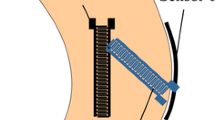Abstract
Fabric-based knee braces are widely used as orthotic devices to support and align the joint. Despite significant prescription, compliance with the treatment is often negatively affected by discomfort issues, in particular brace slippage and migration. Full-field measurements associated with digital image correlation were performed on 11 subjects to determine if the brace was able to follow skin deformation during knee flexion, which was suspected to be a primary slippage mechanism. This technique allowed measurement of relatively small slippage magnitudes, which proved to be mostly reversible on re-extension of the leg. Strain fields derived from these measurements indicated a strong influence of gender on skin deformations, and showed that slippage may be due to the inability of the brace fabric to match the non-linear mechanical behaviour of the skin. Consequently, compliance to knee braces may be improved by differentiating their design between genders and judiciously selecting fabrics based on their mechanical behaviour.










Similar content being viewed by others
References
Agache PG, Monneur C, Leveque JL, Rigal JD (1980) Mechanical properties and young’s modulus of human skin in vivo. Arch Dermatol Res 269(3):221–232. doi:10.1007/BF00406415
Avril S, Feissel P, Pierron F, Villon P (2008) Estimation of the strain field from full-field displacement noisy data: comparing finite elements global least squares and polynomial diffuse approximation. European Journal of Computational Mechanics/Revue Européenne de Mécanique Numérique 17(5–7):857–868
Badulescu C, Bornert M, Dupré JC, Equis S, Grédiac M, Molimard J, Picart PRR (2013) Demodulation of spatial carrier images: Performance analysis of several algorithms. Exp Mech 53:1357–1370. doi:10.1007/s11340-013-9741-6
Berge-Gras R, Molimard J (2009) Optimisation de la dérivation en fonction de la résolution et de la résolution spatiale sur les déformations. In: Actes du XIXème Congrès Français de Mécanique, Marseille
Bethke K (2005) The second skin approach : skin strain field analysis and mechanical counter pressure prototyping for advanced spacesuit design. Thesis, Massachusetts Institute of Technology
Breque C, Dupre JC, Bremand F (2004) Calibration of a system of projection moiré for relief measuring: biomechanical applications. Opt Lasers Eng 41(2):241–260. doi:10.1016/S0143-8166(02)00198-7. http://www.sciencedirect.com/science/article/pii/S0143816602001987
Brownstein B (1998) Migration and design characteristics of functional knee braces. J Sport Rehabil 7(1):33–43
Chew KTL, Lew HL, Date E, Fredericson M (2007) Current evidence and clinical applications of therapeutic knee braces. Am J Phys Med Rehabil 86(8):678–686. doi:10.1097/PHM.0b013e318114e416
CMV AG (2014). Contrex online documentation., http://www.con-trex.ch/index.php?option=com_content&task=blogcategory&id=15&Itemid=82, [Online; accessed 21-March-2014]
Cua AB, Wilhelm KP, Maibach HI (1990) Elastic properties of human skin: relation to age, sex, and anatomical region. Arch Dermatol Res 282(5):283–288. doi:10.1007/BF00375720
Diridollou S, Black D, Lagarde J, Gall Y, Berson M, Vabre V, Patat F, Vaillant L (2000) Sex- and site-dependent variations in the thickness and mechanical properties of human skin in vivo. Int J Cosmet Sci 22(6):421–435. doi:10.1111/j.1468-2494.2000.00037.x
Evans SL, Holt CA (2009) Measuring the mechanical properties of human skin in vivo using digital image correlation and finite element modelling. The Journal of Strain Analysis for Engineering Design 44(5):337–345. doi:10.1243/03093247JSA488
Guimberteau J, Sentucq-Rigall J, Panconi B, Boileau R, Mouton P, Bakhach J (2005) Introduction à la connaissance du glissement des structures sous-cutanées humaines. Ann Chir Plast Esthet 50(1):19–34. doi:10.1016/j.anplas.2004.10.012
iData Research (2012) U.S. market for orthopedic braces & support devices 2012. Tech. rep
Institut Français du Textile et de l’Habillement (2006) Campagne nationale de mensuration
Molimard J, Navarro L (2013) Uncertainty on fringe projection technique: a Monte-Carlo-based approach. Optics and Laser in Engineering 51(7):840–847
Molimard J, Boyer G, Zahouani H (2010) Frequency-based image analysis of random patterns: an alternative way to classical stereocorrelation. Journal of the Korean Society for Nondestructive Testing 30(3):181–193
Ounpuu S (1994) The biomechanics of walking and running. Clin Sports Med 13(4):843–863
Pierrat B, Molimard J, Navarro L, Avril S, Calmels P (2013) Evaluation of the mechanical efficiency of knee braces based on computational modeling
Pierrat B, Molimard J, Navarro L, Avril S, Calmels P (2014) Evaluation of the mechanical efficiency of knee orthoses: a combined experimental-numerical approach. Proceedings of the Institution of Mechanical Engineers. Part H: J Eng Med 228(6):533–546. doi:10.1177/0954411914533944
Regalbuto MA, Rovick JS, Walker PS (1989) The forces in a knee brace as a function of hinge design and placement. The American journal of sports medicine 17(4):535–543
Singer J, Lamontagne M (2008) The effect of functional knee brace design and hinge misalignment on lower limb joint mechanics. Clin Biomech 23(1):52–59. doi:10.1016/j.clinbiomech.2007.08.013
Thoumie P, Sautreuil P, Mevellec E (2001) Orthèses de genou. première partie : Évaluation des propriétés physiologiques à partir d’une revue de la littérature. knee orthosis. first part: evaluation of physiological justifications from a literature review. Ann Readapt Med Phys 44(9):567–580. doi:10.1016/S0168-6054(01)00157-X
Thoumie P, Sautreuil P, Mevellec E (2002) Orthèses de genou. Évaluation de l’efficacité clinique à partir d’une revue de la littérature. Ann Readapt Med Phys 45(1):1–11. doi:10.1016/S0168-6054(01)00166-0
Van Leerdam N (2006) The genux, a new knee brace with an innovative non-slip system. In: Academy of American Orthotists and Prosthetists, Chicago
Acknowledgements
This work was funded in part by the ANRT (Association Nationale de la Recherche et de la Technologie) and the following orthotic manufacturers: Thuasne Ⓡ, Gibaud Ⓡ and Lohmann-Rauscher Ⓡ.
Author information
Authors and Affiliations
Corresponding author
Rights and permissions
About this article
Cite this article
Pierrat, B., Millot, C., Molimard, J. et al. Characterisation of Knee Brace Migration and Associated Skin Deformation During Flexion by Full-Field Measurements. Exp Mech 55, 349–360 (2015). https://doi.org/10.1007/s11340-014-9947-2
Received:
Accepted:
Published:
Issue Date:
DOI: https://doi.org/10.1007/s11340-014-9947-2




